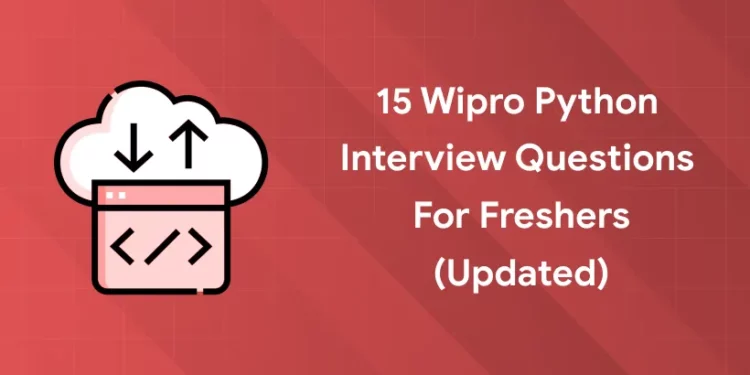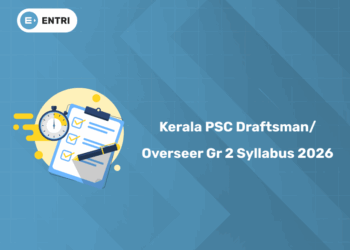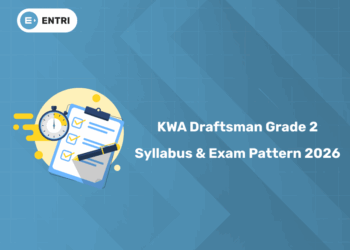Table of Contents
Preparing for a Python interview can be a bit overwhelming, especially if you are a fresher. And, if the interview is for a company like Wipro, you need to prepare with some top-notch materials. This blog provides you with interview questions with answers for you to get an idea of what a Wipro Python interview would be.
Check out this video by Entri in Malayalam!
Introduction: About Wipro
An international company based in India, Wipro Limited offers business process outsourcing, consulting, and information technology services. It is one of the leading suppliers of business process outsourcing (BPO) and IT services worldwide. The organisation provides all-inclusive IT services and solutions, including information systems outsourcing and systems integration. Research and development services, application development and maintenance, and the implementation of IT-enabled service packages for global corporations.
Experience the power of our Python programming course with a free demo – enroll now!
With more than 200,000 committed workers serving customers on six continents, it is well-known throughout the world for its broad range of services, steadfast dedication to sustainability, and superior corporate responsibility. To build a brighter, bolder future, we uncover novel concepts and make the necessary connections.
Why Wipro?
The third-biggest IT firm in India is called Wipro. Being employed by this company is the realisation of a dream. Here, your qualities will be respected. The organisation operates across multiple disciplines and countries, and it possesses strong policies and competencies. Depending on your skills, you’ll have a few alternatives once inside. Without a doubt, Wipro has excellent team management and infrastructure. Additionally, Wipro has an excellent work-life balance.
The company is the world’s first PCMM Level 5 and an IT services provider accredited to SEI CMM Level 5. They lead the Indian market in offering software solutions, network integration, system integration, and IT services to the country’s corporate sector. They provide IT solutions and services to global organisations in the Asia-Pacific and Middle East regions.
Career Options for Python at Wipro
1: Which of the following data types is immutable in Python?
A career at Wipro offers the chance to reach your full potential, advance steadily, and collaborate with some of the most intelligent people in the business while working on cutting-edge technologies. The stimulating combination of development potential, continuous innovation, fair play, and excellent work culture makes Wipro an attractive place to work.
One of the things that sets Wipro apart as a boundary-less organisation is its capacity to grant each employee the autonomy to develop professionally. According to Wipro, individuals and their creative know-how are the only ways to increase organisational efficiency. If you are passionate about working with cutting-edge technology and possess the necessary talent, Wipro is the right place for you. Please refer to the list of qualifying conditions below.
Eligibility Requirement:
- Applicants with a five-year integrated degree or a B.E./B.Tech
- M.Tech holders are qualified.
- Every branch, with the exception of agriculture, food technology, textile engineering, and fashion technology, is allowed to participate in the hiring process.
- The offer is only valid if all backlogs are resolved.
- A student may take a maximum of three years off from school (10th to graduation).
- In the tenth and twelfth grades, 60% or more.
- 60% or 6.0 CGPA, or the equivalent, depending on what your university requires for graduation.
Experience the power of our Python programming course with a free demo – enroll now!
🚀 Start Coding Today! Enroll Now with Easy EMI Options. 💳✨
Gain expertise in Django and open doors to lucrative opportunities in web development.
Start Learning With EMI Payment OptionsWipro Interview Process
1. Interview Process
- Online assessment
- Technical interview
- HR interview
2. Interview Rounds
Online Test
- Quantitative Aptitude: During this stage, the candidate’s aptitude for mathematics will be evaluated. The Quantitative Aptitude subject covers Time, Speed & Distance, Number Series, Simple & Compound Interest, Probability, Permutation & Combination, Ratios & Proportions, and Percentages.
- Logical Reasoning: This section will evaluate the applicant’s capacity for critical and logical thought. Coding, decoding, series, analogy, and visual reasoning, data sufficiency, data interpretation, data arrangements, logical word sequence, statements and inferences, and inequality are among the subjects covered in this section of the test.
- Verbal Ability: The candidates’ English proficiency will be evaluated in this portion. The questions in this part will centre on the following topics: error-spotting, sentence completion, improvement, and parajumbles.
Essay writing: The writing component includes an essay writing test that can be based on any subject or situation. Applicants are required to prepare a 200–400-word essay on the given subject. It is a computer-based test as well. An excellent Wipro essay should include the following: The essay is well-structured, has appropriate vocabulary, and is well phrased with proper language, punctuation, and spelling.
Coding: The following programming languages are available for candidates to take the coding assessment in: Python, Java, C, C++, and C. A minimum of one programming language of the student’s choosing must be learned in Fundamentals of Programming. In this round, there are typically two or three code questions asked. The subjects that need to be learned are as follows: Looping, Strings, Arrays, Functions, and Decision Making.
Technical Interview
- Those who make it through the online assessment phase will be invited to in-person technical interviews.
- In a technical interview, your technical skills are assessed about the technical knowledge that is often needed for the position that you have applied for. Your ability to solve problems and use numerical reasoning will be put to the test by these questions.
- In addition to technical knowledge (which is essential), interviewers are also interested in how candidates approach challenges, formulate their thought processes, and exhibit interpersonal skills like communication.
- The most important part of the procedure is the technical in-person interview. The interviewer should be able to explain computer concepts like OOPS, DBMS, CN, OS, etc. to you if you are not familiar with them.
- Knowledge of a programming language is required. Make sure you are familiar with a minimum one programming language.
- While mastery of every programming language is not required, you should at least be conversant in one, such as Python, Java, or C++. You might also be required to write code.
- The interviewer will also assess your ability to solve problems. You’ll be questioned regarding your prior work and experiences in the workplace, including what you accomplished, how you used technology, and how effective it was.
- The number of technical interviews that will take place will depend on your past performance in rounds one through three, your job profile, and the needs of the firm.
HR Interview
- Every company has an HR interview round to evaluate your character, abilities, weaknesses, and suitability for the job. It also looks at your background to see if you’re the right person for the job.
- Those who pass the technical interview will move on to the HR phase. Inquiries concerning Wipro’s background, including its founding date, objectives, guiding principles, and organisational structure, are also welcome.
- Check your resume to make sure all the information you have supplied about yourself is correct to the best of your knowledge and that you have included all relevant information.
Wipro Interview Questions for Freshers in Python
Q1. What Distinguishes a Deep Copy from a Shallow Copy?
Answer:
The child objects of the original object are created by Deepcopy and then added to a new object. As such, modifications made to the original item do not appear in the duplicate.
- A Deep Copy is produced via copy.deepcopy().
By creating a new object and populating it with references to the child objects inside the old object, shallow copy creates an alternative object. As such, modifications made to the original item are mirrored in the duplicate.
- A Shallow Copy is produced by copy.copy.
Q2. Why Wipro?
Answer: If a query like this is posed, an answer like Wipro is the best IT company in India will be returned. It offers a fantastic workplace. Your attributes will be respected here. The company has operated in several nations and domains. Depending on your professional abilities, you will have a number of options once you are inside. In addition, Wipro offers a strong team environment and a great work-life balance.
Q3. What makes working with Wipro your choice?
Answer: A strong track record of innovation and achievement is why I want to work with Wipro. Since Wipro has been in operation since 1940, I have been impressed with the company. Whenever I consider how technology has evolved from the 1940s to the present, I know that Wipro could not have succeeded unless it welcomed the change.
Q4. What does Python’s docstring mean?
Answer: The first statement in the definition of a function, class, module, or method is called docstring. Additionally, docString offers an improved method for associating the documentation.
Q5. In Python, what are functions?
Answer: Code snippets known as functions are only run when they are invoked. The def keyword in Python is used to define a function.
Q6. How Does Python Achieve Multithreading?
Answer: Generally speaking, multithreading means that several threads are running simultaneously. The Python interpreter can never be held by more than one thread at once thanks to the Python Global Interpreter Lock. Thus, context switching is the method used in Python to accomplish multithreading. Compared to multiprocessing, which essentially opens up many processes across multiple threads, it is very different.
Q7. What is Django Architecture.
Answer: The web service Django is used to create webpages. This is how its architecture looks:
- Template: the page’s main content
- Model: data storage system on the back end
- View: It communicates with the template and model, mapping them to the URL
- Django: provides the user with the page
Q8. How Can the Content of a Text File Be Shown in Reverse Order?
Answer: The steps below can be used to view a text file’s contents in reverse order:
- Use the open() function to open the file.
- Put the file’s contents into a list.
- Turn the list’s contents around.
- To iterate through the list, run a for loop.
Q9. What is functional or object-oriented programming in Python?
Answer:
The language Python is regarded as multi-paradigm.
Python is an object-oriented programming language.
- Python enables the construction of objects and the application of certain methods to manipulate them.
- It supports the majority of OOPS capabilities, including polymorphism and inheritance.
The functional programming paradigm is used in Python.
- Python supports Lambda functions, which are a feature of the functional paradigm, and functions can be utilised as first-class objects.
Experience the power of our Python programming course with a free demo – enroll now!
Q10. Which are the main characteristics of Python 3.9.0.0?
Answer:
- Two new modules are graphlib and zoneinfo.
- Enhanced modules, including ast and asyncio.
- Improved idiom for signal handling, assignment, and Python built-ins are among the optimisations.
- Elimination of incorrect procedures and features.
- A new parser based on PEG is used in place of LL1.
- Prefixes and suffixes can be eliminated using new string methods.
- Type-hinted generics in standard collections.
Q11. How is memory managed in Python?
Answer:
- Python manages memory through its private heap space.
- All Python objects and data structures are stored in a private heap.
- The programmer cannot access this private heap. Rather, the Python interpreter handles that.
- Additionally, Python has an integrated garbage collector that recycles all leftover memory and releases it into the heap.
- It is the responsibility of Python’s memory management to allocate heap space for Python objects. Programmers can access certain programming tools using the core API.
Q12. What advantages do NumPy arrays have over Python lists, even nested ones?
Answer:
- Python lists are practical general-purpose containers. They are easy to generate and use thanks to Python’s list comprehensions, and they enable (relatively) fast insertion, deletion, appending, and concatenation.
- Their restrictions include the inability to perform “vectorized” operations like as elementwise addition and multiplication, and the need for Python to keep type information for each element and run type dispatching code while working on it due to their ability to include objects of multiple types.
- In addition to having many features including histograms, algebra, linear, basic statistics, quick searching, convolutions, FFTs, and more, NumPy arrays are faster.
Q13. What are the differences between Pyramid, Django, and Flask.
Answer:
- Pyramid was made with larger apps in mind. It provides developers with flexibility and lets them use the right tools for the jobs at hand. The developer has access to the database, URL structure, templating style, and other settings. Pyramid is easily adaptable.
- A “microframework” for small apps with few requirements is called Flask. In a flask, external libraries are necessary. You can now utilise the flask.
- Pyramid and Django can both be utilised for larger applications. It contains an ORM.
Q14. Which kinds of literals are there in Python?
Answer: In Python source code, a literal denotes a fixed value for primitive data types. The five categories of literals in Python are as follows:
- String Literal: When you assign text enclosed in single or double quotes to a variable, you create a string literal. To create multiline literals, assign the multiline text enclosed in triple quotes.
- Numerical Literal: They could include complex numbers, integers, or floating-point data.Literal
- Character: A single character is created by enclosing it in double quotes.
- Literal Boolean: True or False
- Literal Collections: List collections, tuple literals, dictionary literals, and set literals are the four different categories of literals.
Q15. Tell the difference between xrange and range.
Answer: Range and xrange are nearly identical in terms of functionality. The ability to generate a list of numbers for any purpose is something they both offer. Range creates a Python list object, whereas x range returns an xrange object. This is the only distinction between range and xrange. Range will use all available memory to build your array of numbers, which could result in a memory problem and crash your programme. This is particularly true if you are working with a system that needs a lot of memory, like a phone. It is a beast that suffers from memory loss.
Wipro Python Interview Questions: Conclusion
🚀 Start Coding Today! Enroll Now with Easy EMI Options. 💳✨
Gain expertise in Django and open doors to lucrative opportunities in web development.
Start Learning With EMI Payment Options











